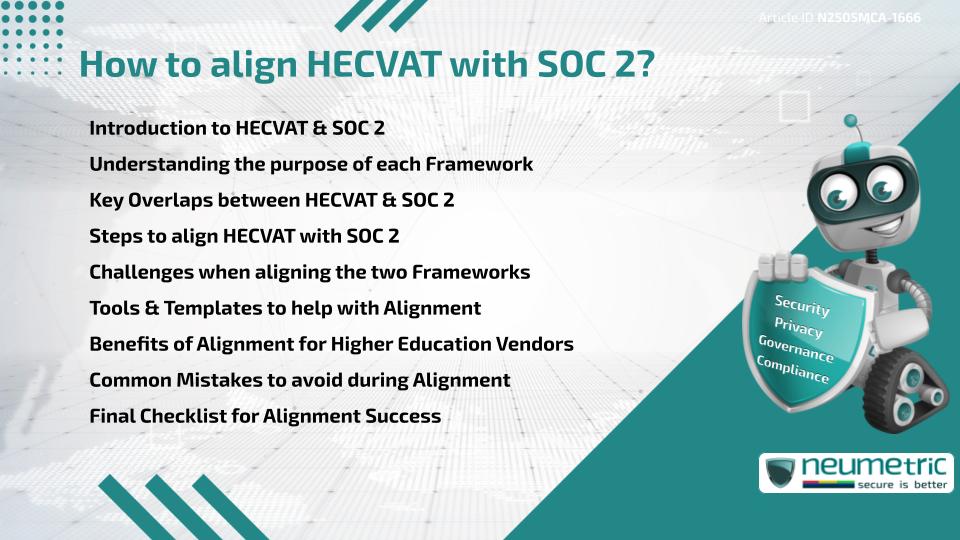Table of Contents
ToggleIntroduction to HECVAT & SOC 2
In the world of Data Security, especially for Cloud-based Service Providers, two names stand out: the Higher Education Community Vendor Assessment Tool [HECVAT] and the Service Organisation Control 2 [SOC 2] Report. Each serves a different Audience but shares a common goal—ensuring Data Security, Privacy & Trust.
For SaaS Vendors working with Universities, the need to understand how to align HECVAT with SOC 2 has become a top priority. This article explains their similarities, differences & how Organisations can streamline Compliance across both.
Understanding the purpose of each Framework
HECVAT was developed by the Higher Education Information Security Council to help Institutions assess Third Party Vendors based on standardised Security Practices. It includes detailed Questionnaires focusing on Cloud Service Risk, Data Handling, Access Control & Business Continuity.
SOC 2, on the other hand, is an Independent Audit Report based on the Trust Services Criteria developed by the American Institute of Certified Public Accountants [AICPA]. It evaluates how well an Organisation manages Data related to Security, Availability, Confidentiality, Privacy & Processing Integrity.
While HECVAT is a Self Assessment tool & SOC 2 requires Third Party validation, both aim to reduce Risk & improve Accountability.
Key Overlaps between HECVAT & SOC 2
Understanding how to align HECVAT with SOC 2 starts with identifying their overlapping themes:
- Security Controls: Both focus on Access Management, Encryption & Secure Configurations.
- Data Privacy: HECVAT includes questions related to Data Classification & Handling, which map to SOC 2’s Privacy Criteria.
- Incident Response: Each demands clear Policies for managing Breaches & Security Events.
- Governance: Policies, Training & Internal oversight are key in both Frameworks.
Although they differ in structure & depth, these overlaps make it possible to cross-reference efforts & reduce duplicate work.
Steps to align HECVAT with SOC 2
To understand how to align HECVAT with SOC 2, follow these practical steps:
- Perform a Gap Analysis
Begin by comparing the HECVAT Lite or Full Questionnaire with your latest SOC 2 Type 1 or Type 2 Report. Map each question in HECVAT to the SOC 2 Controls or Evidence already collected. - Use Existing Audit Data
Where applicable, reuse SOC 2 Evidence such as System descriptions, Policies & Test results to fill in HECVAT fields. - Document Differences
Some HECVAT items, like specific Educational Data handling or FERPA concerns, may not appear in SOC 2. Address these with additional Documentation. - Develop a Crosswalk Table
Create a Spreadsheet that links each HECVAT Question to a relevant SOC 2 Control. This Tool saves time & ensures consistency across Audits. - Engage both Security & Compliance Teams
Successful alignment requires input from multiple roles—Security Officers, Auditors & Compliance Leads.
This approach minimises effort & supports Vendor Trust across Higher Education Partnerships.
Challenges when aligning the two Frameworks
Knowing how to align HECVAT with SOC 2 doesn’t remove the barriers that often appear:
- Different Auditing Styles: SOC 2 is externally validated while HECVAT is internally filled, which may raise consistency concerns.
- Inconsistent Terminology: Language in HECVAT may not match SOC 2 Criteria exactly, requiring interpretation.
- Missing Elements: SOC 2 does not always cover Educational-specific Risks like FERPA or Student Records.
Tools & Templates to help with Alignment
Several tools can support the process:
- Internal Compliance Platforms that integrate SOC 2 Evidence into Self Assessment Forms
- Workflow Tools that link Document Repositories with Audit Questions
Using structured tools makes it easier to show due diligence without starting from scratch.
Benefits of Alignment for Higher Education Vendors
If your Organisation serves Colleges or Universities, learning how to align HECVAT with SOC 2 provides measurable benefits:
- Reduces Redundant Work: Save time by reusing Evidence across both Assessments.
- Builds Trust Faster: Higher Education Clients are more likely to onboard Compliant Vendors.
- Improves Audit Readiness: Keeps you prepared for both Internal & External Audits.
- Boosts Security Maturity: Identifying & closing Gaps improves overall Security Posture.
This alignment supports both Operational Efficiency & better Relationships with Academic Clients.
Common Mistakes to avoid during Alignment
Despite good intentions, teams often make errors when aligning the two:
- Copying Without Context: Simply pasting SOC 2 responses into HECVAT without adapting the language may result in poor clarity.
- Neglecting Role-Based Controls: SOC 2 covers them, but HECVAT demands more specific answers related to who does what.
- Skipping Periodic Reviews: Alignment is not a one-time task. Both Documents should be refreshed regularly.
Awareness of these pitfalls can help Vendors stay Audit-ready year-round.
Final Checklist for Alignment Success
Use this quick Checklist to stay on track:
- Complete Gap Analysis between HECVAT & SOC 2
- Map Controls using a Crosswalk Tool
- Address missing Educational-specific Risks
- Reuse validated SOC 2 Evidence
- Review HECVAT responses with Internal Teams
- Update both Documents regularly
This ensures that your alignment process is thorough, transparent & efficient.
Takeaways
- HECVAT & SOC 2 have different formats but share key goals.
- Mapping their Controls helps vendors reduce Duplication.
- Educational Clients expect clear Evidence of Compliance with both.
- A planned alignment process saves time & builds Client confidence.
FAQ
What is the easiest way to start learning how to align HECVAT with SOC 2?
Start by downloading a HECVAT Lite Template & comparing it with your latest SOC 2 Type 2 Report. Then map the common Controls.
Do I need to be SOC 2 compliant to complete HECVAT?
No, but having SOC 2 Compliance can make it easier to respond to HECVAT accurately & credibly.
Can a Third Party Consultant help with how to align HECVAT with SOC 2?
Yes, Consultants who specialise in Security Frameworks can provide Mappings & Templates to fast-track the alignment process.
Are there free resources to guide how to align HECVAT with SOC 2?
Yes, websites like EDUCAUSE & Internet2 offer free Tools, Guides & Templates.
What if our SOC 2 Scope does not cover all areas in HECVAT?
You can supplement your SOC 2 Evidence with additional Policies or Procedures tailored to Higher Education concerns.
Does aligning HECVAT with SOC 2 mean we don’t need separate Documentation?
No, but you can streamline your Documentation by referencing shared Controls & linking Evidence from one Framework to the other.
How often should we update our HECVAT if we have a valid SOC 2 Report?
At least annually or whenever major changes occur in your System or Policies.
Need help?
Neumetric provides organisations the necessary help to achieve their Cybersecurity, Compliance, Governance, Privacy, Certifications & Pentesting goals.
Organisations & Businesses, specifically those which provide SaaS & AI Solutions, usually need a Cybersecurity Partner for meeting & maintaining the ongoing Security & Privacy needs & requirements of their Clients & Customers.
SOC 2, ISO 27001, ISO 42001, NIST, HIPAA, HECVAT, EU GDPR are some of the Frameworks that are served by Fusion – a centralised, automated, AI-enabled SaaS Solution created & managed by Neumetric.
Reach out to us!


